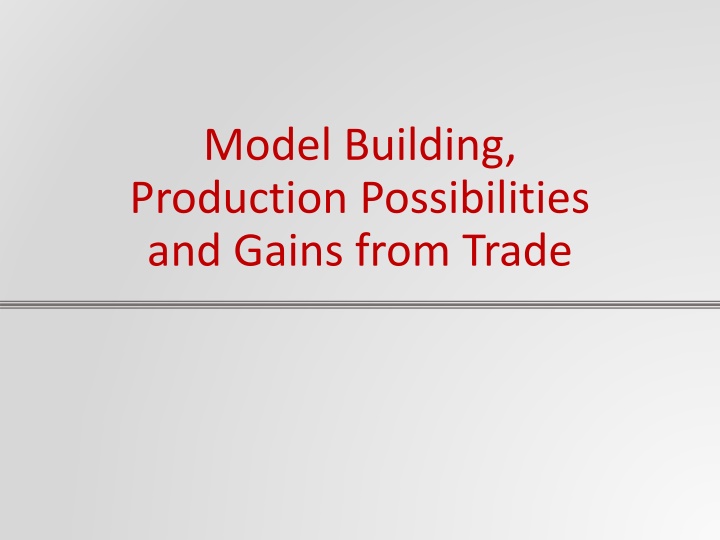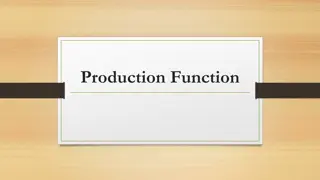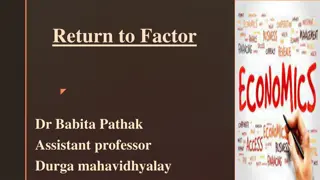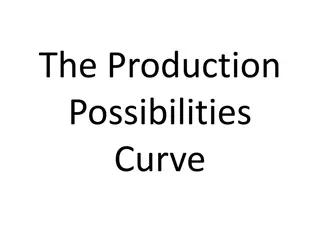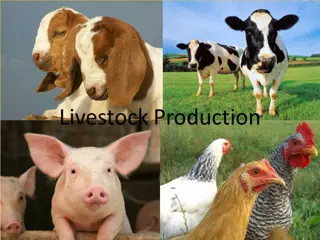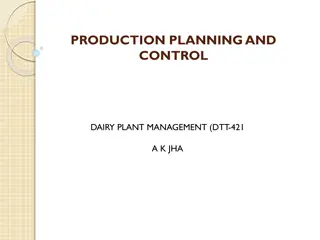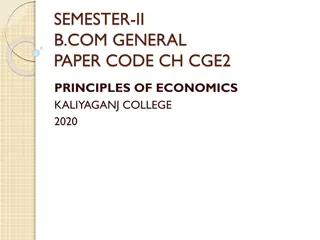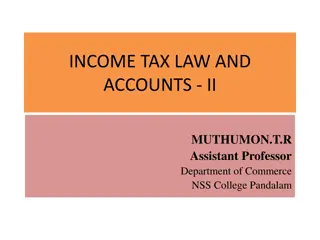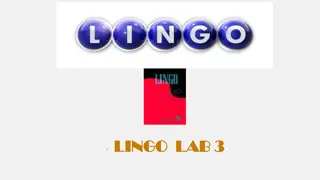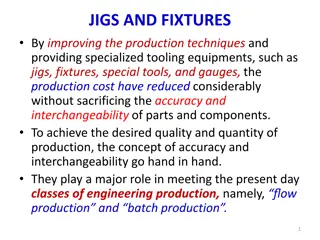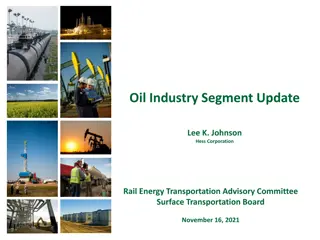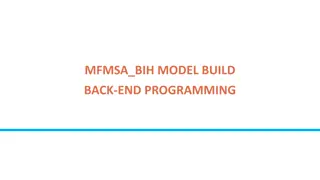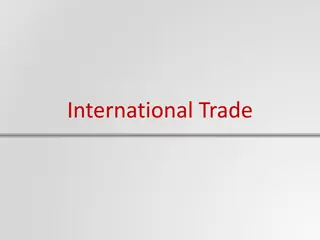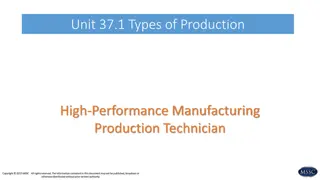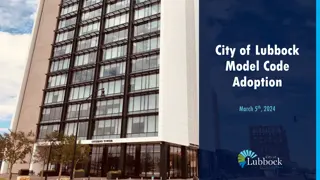Model Building, Production Possibilities, and Gains
This presentation delves into economic concepts such as budget constraints, opportunity costs, production possibilities frontiers, and choices individuals make in the face of tradeoffs. It explores the key questions surrounding how decisions are influenced and the impact of various factors on decision-making processes.
Download Presentation

Please find below an Image/Link to download the presentation.
The content on the website is provided AS IS for your information and personal use only. It may not be sold, licensed, or shared on other websites without obtaining consent from the author.If you encounter any issues during the download, it is possible that the publisher has removed the file from their server.
You are allowed to download the files provided on this website for personal or commercial use, subject to the condition that they are used lawfully. All files are the property of their respective owners.
The content on the website is provided AS IS for your information and personal use only. It may not be sold, licensed, or shared on other websites without obtaining consent from the author.
E N D
Presentation Transcript
Model Building, Production Possibilities and Gains from Trade
Acknowledgments This PowerPoint presentation is based on and includes content derived from the following OER resource: Principles of Microeconomics An OpenStax book used for this course may be downloaded for free at: https://openstax.org/details/books/principles-microeconomics-2e 2
Key Questions How do individuals make choices based on their budget constraint? What do we mean by opportunity cost? What is the Production Possibilities Frontier? What are the objections the to economic approach? 3
Choices and Tradeoffs Credit: modification of work by Jim, the Photographer /Flickr Creative Commons) In general, the higher the degree, the higher the salary. So why aren t more people pursuing higher degrees? The short answer: choices and tradeoffs. 4
Choice and the Budget Constraint The budget constraint is all possible consumption combinations of goods that someone can afford, given the prices of goods, when all income is spent. The budget constraint is the boundary of the opportunity set. The opportunity set is all possible combinations of consumption that someone can afford given the prices of goods and the individual s income (all income does not need to be spent). With a limited amount of income to spend on things, consumers must choose what they need and want. 5
Graphing the Budget Constraint: Alphonso s Consumption Choice Each point on the budget constraint represents a combination of burgers and bus tickets whose total cost adds up to Alphonso s budget of $10. The slope of the budget constraint is determined by the relative price of burgers and bus tickets. Giving up one burger means gaining four bus tickets. The opportunity set - every point on (or inside) the constraint which shows a combination of burgers and bus tickets that Alphonso can afford. Any point outside the constraint is not affordable given Alphonso s budget. 6
The Concept of Opportunity Cost Opportunity cost - indicates what one must give up to obtain what he or she desires. The cost of one item is the lost opportunity to do or consume something else. The opportunity cost is the value of the next best alternative. A fundamental principle of economics is that every choice has an opportunity cost. As shown on the previous slide, for Alphonso, the opportunity cost of a burger is the four bus tickets he would have to give up. 7
Identifying Opportunity Cost In many cases, it is reasonable to refer to the opportunity cost of something as its price. For example, if you buy a bicycle for $300, then $300 measures the amount of other consumption that you have foregone. But the dollar price may not capture the entire opportunity cost, as in cases where costs of time are involved. For example, the out-of-pocket costs of attending college include tuition, books, room and board, and other expenses. However, during the hours you are attending class and studying, you can t work at a paying job. So, college imposes both an out-of-pocket cost and an opportunity cost of lost earnings. 8
Other Opportunity Cost Examples Discussion Question: What are the opportunity costs of the following? Buying vs. leasing a car Investing in different ways (i.e. savings accounts, certificates of deposit, mutual funds, stocks, etc.) Going out to eat vs. preparing food at home Walking or taking public transportation 9
Marginal Decision-Making and Diminishing Marginal Utility Marginal analysis - examining the benefits and costs of choosing a little more or a little less of a good. Utility - satisfaction, usefulness, or value one obtains from consuming goods and services. Law of diminishing marginal utility - as a person consumes more of a good, the additional, or marginal, utility from each additional unit of the good declines. Example - the sixth slice of pizza eaten yields much less satisfaction than the first. 10
Sunk Costs Sunk costs - costs that were incurred in the past and cannot be recovered. For people and firms alike, dealing with sunk costs can be frustrating. For example, a firm finds it hard to give up on a new product that is doing poorly just because of the money that was spent in creating and launching it. The lesson of sunk costs is to ignore the past errors and make decisions based on what will happen in the future. 11
The Production Possibilities Frontier and Social Choices Production Possibilities Frontier (PPF) - a diagram that shows the productively efficient combinations of two products that an economy can produce given the resources and technology it has available. The slope of the production possibilities frontier shows the opportunity cost of producing one good in terms of the amount of the other good foregone. 12
Production Possibilities Frontier: Healthcare vs. Education (1 of 2) Here, the production possibilities frontier shows a tradeoff between devoting resources to healthcare and education. At point A, all resources go to healthcare; at point B, most go to healthcare. At point D, most resources go to education, and at point F, all resources go to education. 13
Production Possibilities Frontier: Healthcare vs. Education (2 of 2) A society could choose to produce any combination of healthcare and education on the PPF. It does not have enough resources to produce outside the PPF. Because the PPF is downward sloping from left to right, the only way society can obtain more education is by giving up some healthcare. 14
The Shape of the PPF and Diminishing Returns (1 of 2) The law of diminishing returns - as additional increments of resources are added to the production of a good or service, the additional increments of output will decline. The law of diminishing marginal utility defined earlier is a more specific case of the law of diminishing returns. 15
The Shape of the PPF and Diminishing Returns (2 of 2) The curvature of the PPF shows that as we add more resources to education, moving from left to right along the horizontal axis, the original gains in education are fairly large, but gradually diminish. Likewise, as we add more resources to healthcare, moving from bottom to top on the vertical axis, the original gains are fairly large, but again gradually diminish. 16
The Differences Between the Budget Constraint and the PPF First difference - The budget constraint is a straight line whose slope is given by the relative prices of the two goods, which are fixed, so slope doesn't change. The PPF is curved because of the law of diminishing returns so its slope is different at each point. Second difference - Specific numbers are absent along the axes of the PPF. The exact amount of resources an imaginary economy has is not known. 17
The Similarities Between the Budget Constraint and the PPF The budget constraint and the social production possibilities frontier (PPF) show the constraints under which individual consumers and society as a whole, respectively, operate. Both diagrams show that in choosing more of one good the tradeoff is less of the other good. 18
Productive Efficiency and Allocative Efficiency Productive efficiency - when it is impossible to produce more of one good (or service) without decreasing the quantity produced of another good (or service) Any choice inside the PPF is productively inefficient because it is possible to produce more of one or both goods with the current level of resources and technology. Allocative efficiency - when the mix of goods produced represents the mix that society most desires 19
Productive Efficiency and the PPF All choices along a given PPF like B, C, and D display productive efficiency. Choice R does not, because it is inside the PPF curve, and thus not all resources are being used. 20
The PPF and Comparative Advantage (1 of 2) How much of a good a country decides to produce depends on how expensive it is to produce it versus buying it from a different country. Countries tend to have different opportunity costs of producing different goods, either because of different climates, geography, technology, or skills. Comparative advantage - when a country can produce a good at a lower opportunity cost than another country. 21
The PPF and Comparative Advantage (2 of 2) The U.S. PPF is flatter than that of Brazil implying that the opportunity cost of wheat in terms of sugar cane is lower in the U.S. than in Brazil. Conversely, the opportunity cost of sugar cane is lower in Brazil. The U.S. has comparative advantage in wheat and Brazil has comparative advantage in sugar cane. 22
Using the PPF to Illustrate Growth Over Time Good Y PPFYear 1 PPFYear t Good X Over time, as productive resources increase, or technology advances, the economy s capacity to produce goods and services grows. This is shown by the outward shift of the PPF from Year 1 to Year t. 23
Confronting the Objections to the Economic Approach (1 of 3) The first objection is that people, firms, and society do not act in a way that fits the economic way of thinking. However, it is reasonable as a first approximation, to analyze them with the tools of economic analysis. Will be addressed in a later chapter on consumer choices. 24
Confronting the Objections to the Economic Approach (2 of 3) The second objection is that people, firms, and society should not act in a way that fits the economic way of thinking. The economics approach: Portrays people as self-interested. Economics is not intended as a form of moral instruction. Seeks to describe economic behavior as it actually exists. Uses positive statements which describe the world as it is. These are factual. Tries to avoid normative statements, which describe how the world should be. These are based on opinion. 25
Confronting the Objections to the Economic Approach (3 of 3) The invisible hand refers to the idea that individuals' pursuit of self-interest can lead to positive social outcomes Identified by Adam Smith in The Wealth of Nations . Consumers will encourage businesses to offer goods and services that meet their needs. It is possible that broader social good can emerge from selfish individual actions. Self-interest in economics does not imply self-interest in all aspects of life. People s freedom to make their own economic choices has a moral value worth respecting. 26
